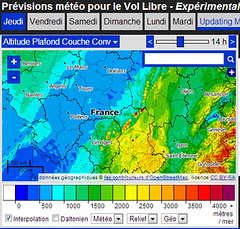See also “Opening the weather, part 1”
I began paragliding a few years ago. It’s maybe the most weather-dependent sport in the world. We often fly in mountainous areas, very close to the ground. We need to know about local effects like thermal updrafts, clouds growth, mountain-breeze, foehn wind and all sorts of other micro weather effects.
I discovered there was very little information available at this level of detail. The information exists, but is not displayed anywhere because it’s too specific.
I asked our National Weather Service “Météo France”, if they could provide me with the raw data I needed to make my own paragliding forecasts. They told me “Fine, it’s €100,000 a year”. A little bit too expensive for my personal use (or for any mobile app developer)…
Investigations revealed that only a few public agencies globally share this data freely, mostly based in the US, Canada and Norway. I got some data from the US global model (GFS), which is used for pretty much every weather website. But those forecasts are very limited. The global model is really coarse (55km grid), and cannot see topography or land use. It doesn’t even see the Alps – not so very useful for paragliding.
To get the data at the level I need, I have to run my own high-resolution regional weather model, using coarse US data as input (see my meteo-parapente.com website). It’s not easy. It requires High Performance Computing (HPC) technology, with our own computing cluster, servers and archiving infrastructure.

This project started as a personal attempt to get better weather info for my paragliding, but the process has made me realise there are bigger issues at stake.
Everybody knows weather has an impact on most activities. According to METNEXT, 25% of France’s GDP is dependent on weather.
Weather is cheap: when you spend a dollar for better weather knowledge, you save more than 20 avoiding loss and fatalities during severe weather. Margaret Zeigler at #openagdata points out that 90% of crop losses are due to weather.
In the US, weather data is public domain. But in most European countries, it’s not. Data from model outputs, rain radars, ground stations and satellites is sold for 100,000’s of euros.
This policy has a lot of side effects:
- Free public services are quite bad, because they need to sell “premium” services.
- No startup or SME can afford this price -> No “weather” business in Europe. Growing 1% against 20% in the US.
- public agencies and researchers have big difficulties getting the data they need.
I was sad to learn that my departement is buying weather from a Belgium company instead of from the French national public agency.
So, OpenMeteoData has several goals :
- To provide easy access to already available data.
- To gather people and technical resources for creating open forecasts (both human analysis and numerical models)
- To help institutions to open their data, and explain benefits to them
- To act as a catalyst in the debate about opening public data. I’m already in touch with French government and Météo France.
- To provide a platform to gather projects about open meteorology.
If you’d like to talk about the weather, our Open Sustainability list might be the right place for you!
Nicolas is the founder of OpenMeteoData. He is a keen windsurfer and paraglider, and tweets from @nb4ld









